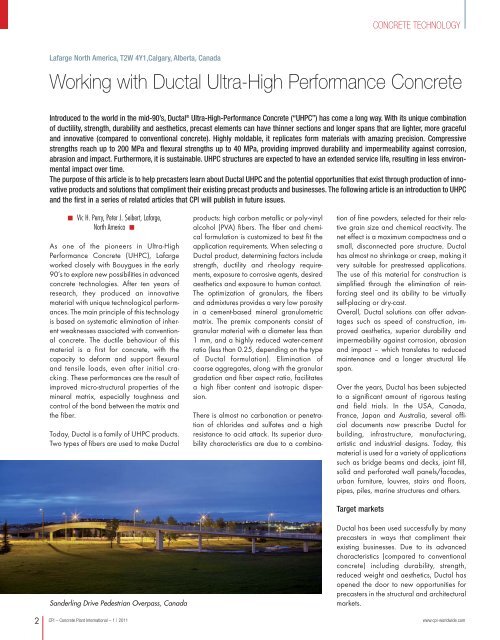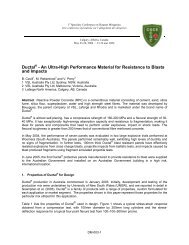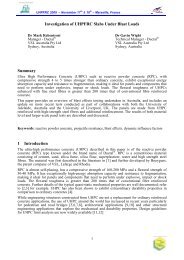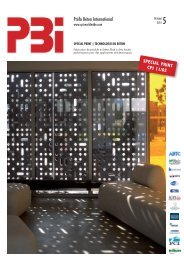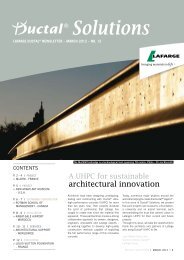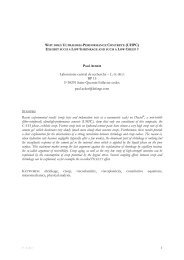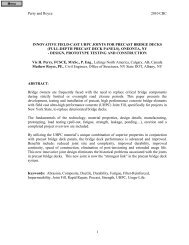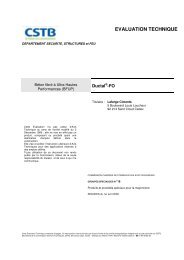CPI - February 2011 - Working with Ductal® UHPC
CPI - February 2011 - Working with Ductal® UHPC
CPI - February 2011 - Working with Ductal® UHPC
You also want an ePaper? Increase the reach of your titles
YUMPU automatically turns print PDFs into web optimized ePapers that Google loves.
CONCRETE TECHNOLOGY<br />
Lafarge North America, T2W 4Y1,Calgary, Alberta, Canada<br />
<strong>Working</strong> <strong>with</strong> Ductal Ultra-High Performance Concrete<br />
Introduced to the world in the mid-90’s, Ductal ® Ultra-High-Performance Concrete (“<strong>UHPC</strong>”) has come a long way. With its unique combination<br />
of ductility, strength, durability and aesthetics, precast elements can have thinner sections and longer spans that are lighter, more grace ful<br />
and innovative (compared to conventional concrete). Highly moldable, it replicates form materials <strong>with</strong> amazing precision. Compressive<br />
strengths reach up to 200 MPa and flexural strengths up to 40 MPa, providing improved durability and impermeability against corrosion,<br />
abrasion and impact. Furthermore, it is sustainable. <strong>UHPC</strong> structures are expected to have an extended service life, resulting in less environmental<br />
impact over time.<br />
The purpose of this article is to help precasters learn about Ductal <strong>UHPC</strong> and the potential opportunities that exist through production of innovative<br />
products and solutions that compliment their existing precast products and businesses. The following article is an introduction to <strong>UHPC</strong><br />
and the first in a series of related articles that <strong>CPI</strong> will publish in future issues.<br />
Vic H. Perry, Peter J. Seibert, Lafarge,<br />
North America<br />
As one of the pioneers in Ultra-High<br />
Performance Concrete (<strong>UHPC</strong>), Lafarge<br />
worked closely <strong>with</strong> Bouygues in the early<br />
90’s to explore new possibilities in ad vanced<br />
concrete technologies. After ten years of<br />
research, they produced an innovative<br />
material <strong>with</strong> unique technological performances.<br />
The main principle of this technology<br />
is based on systematic elimination of inherent<br />
weaknesses associated <strong>with</strong> conventional<br />
concrete. The ductile behaviour of this<br />
material is a first for concrete, <strong>with</strong> the<br />
capacity to deform and support flexural<br />
and tensile loads, even after initial cra -<br />
ck ing. These performances are the result of<br />
improved micro-structural properties of the<br />
mineral matrix, especially toughness and<br />
control of the bond between the matrix and<br />
the fiber.<br />
Today, Ductal is a family of <strong>UHPC</strong> products.<br />
Two types of fibers are used to make Ductal<br />
Sanderling Drive Pedestrian Overpass, Canada<br />
products: high carbon metallic or poly-vinyl<br />
alcohol (PVA) fibers. The fiber and chemical<br />
formulation is customized to best fit the<br />
application requirements. When selecting a<br />
Ductal product, determining factors include<br />
strength, ductility and rheology requirements,<br />
exposure to corrosive agents, desired<br />
aesthetics and exposure to human contact.<br />
The optimization of granulars, the fibers<br />
and admixtures provides a very low porosity<br />
in a cement-based mineral granulometric<br />
matrix. The premix components consist of<br />
granular material <strong>with</strong> a diameter less than<br />
1 mm, and a highly reduced water-cement<br />
ratio (less than 0.25, depending on the type<br />
of Ductal formulation). Elimination of<br />
coarse aggregates, along <strong>with</strong> the granular<br />
gradation and fiber aspect ratio, facilitates<br />
a high fiber content and isotropic dispersion.<br />
There is almost no carbonation or penetration<br />
of chlorides and sulfates and a high<br />
resistance to acid attack. Its superior durability<br />
characteristics are due to a combina -<br />
tion of fine powders, selected for their relative<br />
grain size and chemical reactivity. The<br />
net effect is a maximum compactness and a<br />
small, disconnected pore structure. Ductal<br />
has almost no shrinkage or creep, making it<br />
very suitable for prestressed applications.<br />
The use of this material for construction is<br />
simplified through the elimination of reinforcing<br />
steel and its ability to be virtually<br />
self-placing or dry-cast.<br />
Overall, Ductal solutions can offer advantages<br />
such as speed of construction, im -<br />
proved aesthetics, superior durability and<br />
impermeability against corrosion, abrasion<br />
and impact – which translates to reduced<br />
main tenance and a longer structural life<br />
span.<br />
Over the years, Ductal has been subjected<br />
to a significant amount of rigorous testing<br />
and field trials. In the USA, Canada,<br />
France, Japan and Australia, several offi -<br />
cial documents now prescribe Ductal for<br />
building, infrastructure, manufacturing,<br />
artis tic and industrial designs. Today, this<br />
material is used for a variety of applications<br />
such as bridge beams and decks, joint fill,<br />
solid and perforated wall panels/facades,<br />
urban furniture, louvres, stairs and floors,<br />
pipes, piles, marine structures and others.<br />
Target markets<br />
Ductal has been used successfully by many<br />
precasters in ways that compliment their<br />
existing businesses. Due to its advanced<br />
characteristics (compared to conventional<br />
concrete) including durability, strength,<br />
reduced weight and aesthetics, Ductal has<br />
opened the door to new opportunities for<br />
precasters in the structural and architectural<br />
markets.<br />
2<br />
<strong>CPI</strong> – Concrete Plant International – 1 | <strong>2011</strong><br />
www.cpi-worldwide.com


